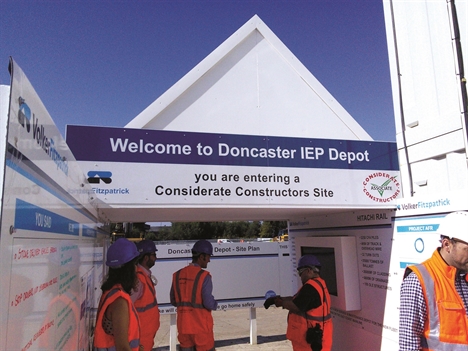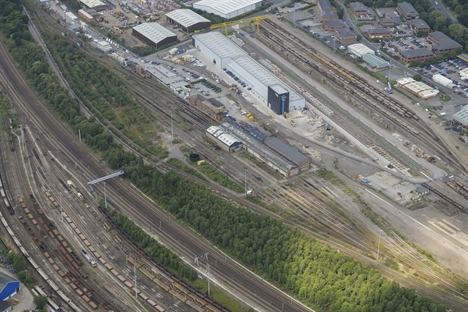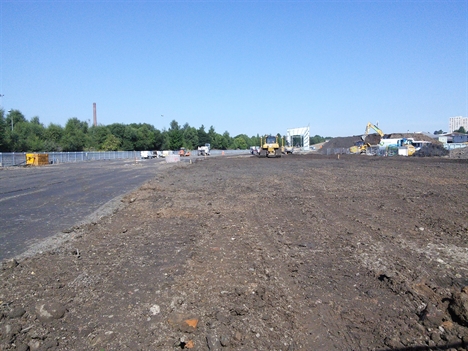07.09.15
The centre of excellence for the East Coast Main Line IEP fleet
Source: RTM Aug/Sep 15
RTM’s Adam Hewitt took a trip to Doncaster to see the depot that is under construction for Hitachi Rail Europe’s Class 800s and 801s. He was shown around by Neil Lindley, contracts director at VolkerFitzpatrick, and Ross Cunningham, head of property and construction at Hitachi Rail Europe.
“You don’t get anything more multidisciplinary than a depot – it has everything.”
Neil Lindley, one of those leading the project to build a £70m new flagship depot on the East Coast Main Line at Doncaster – replacing a now-demolished 130-year old shed that previously occupied the site – says that of all the projects that rail and construction companies get involved with, depots are the most diverse.
VolkerFitzpatrick specialises in multidisciplinary projects, and it has a CP5 workbank of about £800m. But most of those projects, whether bridges, earthworks, track renewals or stations, are actually relatively straightforward, Lindley suggested. “But if you think about all the different elements and assets within a depot – from the specialist kit to the civils to the earthworks to the substructure to the M&E (mechanical and electrical) to the signalling to the OLE to the P-way – it has everything,” he said.

Hitachi Rail Europe (HRE) will operate depots up and down the East Coast Main Line (ECML) from London to Scotland for its new IEP fleet, with the trains themselves to be operated by Virgin Trains East Coast (until 2023 at least). But Doncaster Carr will be the “main centre of excellence” and the hub of the whole operation, according to Ross Cunningham, head of property and construction at HRE, which is also building and upgrading another set of depots for the other IEP fleet on the Great Western Main Line.
Doncaster will be the main base on the ECML for the bi-mode Class 800s and electric Class 801/1s, though the Class 801/2 subclass will be maintained out of Bounds Green in north London.

The main shed is a five-road facility, one of which is for the heaviest maintenance, while the site also features a carriage wash building (pictured below, under construction), under-frame cleaning facility, a CET apron, plus a wheel lathe. This is on top of the sidings, stores and office space on site.

Supporting and enabling all this will be 4km of track and overhead wire, 32 turn-outs, 109 OLE structures, 6.6km of drainage and nearly 2,300 piles. There will also be up to 25,000 tonnes of ballast used, and about 1,300 tonnes of steel.
Suppliers and contractors include NG Bailey for the mechanical and engineering fit-out, plus Trackwork, Airquick, Wilcomatic, Konecranes, Hegenscheidt-MFD, MRX Technologies, Red Viking Rail, Mechan, Schenk Process, and Trough-Tec Systems. EC Harris is the contract and costs manager, and the designers are Arup and RPS.
Zero to landfill
Once Hitachi took possession of the site from DB Schenker in spring 2014, the demolition phase began, lasting about eight months. Lindley and the team were full of admiration for the quality of the Victorian engineering and civils they uncovered as they took down the old buildings and dug into the foundations. “The arches that the original buildings were built on, we’re obviously having to take down and recover, because they’re not strong enough to withstand what we need them to – those sub-foundations we have to take out and restabilise. But after 150 years they’re still intact, they’re perfect.”
Lindley had a similar experience on the King’s Cross project, which was built on inverted arches and massive spans of Yorkstone. “The quality was just immense. The Victorians – they knew how to build!”
The original structure of the Doncaster Carr depot (pictured in the aerial shot below) has now been crushed and either reused or reclaimed, with the absolute minimum sent to landfill. Some of the steelwork was sent off for reclamation, while old sleepers and track were kept as serviceable spares where possible. The timber was taken away by Doncaster-based Trackwork, which is also the joint operator of Network Rail’s new concrete sleeper factory next door to the depot site.

The existing earth at the site was unclassified and unable to achieve a CBR rate of 15% (CBR, or the California Bearing Ratio, is a penetration test to evaluate the strength of road subgrades), meaning it could not be trusted to be free from settlement or movement.

To maintain the commitment to ‘zero to landfill’, the earth – perhaps as much as 60,000 cubic metres of it – is being stabilised and remediated. It is being dug, then aerated to get the natural gases out, stockpiled and dried, then tested, spread, rotavated, and having a lime stabilisation layer put through its first three layers. The final layer has a slag stone layer put through it and then more lime, then it is compacted, getting it to the required grade for classification.

Lindley said: “It’s quite a long process, but it means we’re sending nothing to landfill. We are reusing every bit of earth on this job, which is a massive achievement in itself.”
Landfill would have been the “easy choice”, he said, but it was not one that VolkerFitzpatrick or HRE wanted to take.
BIM in action
The build is making full use of BIM (building information modelling, or ‘better information management’ as some of its evangelists would have it), using a model designed by Arup.
That has been phenomenally useful for clash detection, with about 2,800 potential clashes already uncovered: everything from piling to services to existing underground conditions. “It’s really helped us to not have those construction issues,” Lindley said.
Cunningham called it “a great piece of kit”, adding: “It’s also really good for the [train] operators, as they can see exactly how they want to lay things out.”
He said it was fantastic for construction and design, especially projects with a lot of mechanical and engineering elements, and he could see why major infrastructure schemes like HS2 are setting such great store by BIM.
There is also a separate 3D flythrough showing the construction and final vision, put together by Uxbridge-based Bionic. Watch it below:
Pre-cast units for the substructure
The depot building itself is making use of an innovative construction method to improve the efficiency of the build, using nearly 500 pre-cast concrete units, each weighing nearly 13 tonnes, instead of having steel support columns directly bolted to the slab floor. The track within the depot building sits on foundations made up of flared head piles, with a ‘biscuit’ slab 3m wide and 450mm thick cast in situ. The pre-cast reinforced concrete units sit on top of that, to take the weight of the trains.

The tolerance on the unit Lindley showed us was about 1mm out, which he said he could happily live with. The team is now deciding between two specialist options for lifting them all into place, which will require a series of 14-tonne lifts (including the lifting tackle).
The building itself also has its own piles and columns, of course. Lindley said: “Once you get above ground level you don’t appreciate it, but right now there is an immense amount of engineering going into the substructure of this depot.”
The pre-cast method is a “much sturdier system and ties in better with the slab”, he added. Cunningham said: “We’re always looking to strive for innovation and new methods of doing construction and design.”
Capacity and timing
The depot has a theoretical capacity of 26 half-sets of five cars, though that would restrict movement options, so the optimum maximum is really 24.
The build is on target for completion by Q3 2016, followed by a four to six month testing and commissioning period, with the ultimate handover scheduled for January 2017.
Doing the works in advance of when they’re needed has been a conscious decision on HRE’s part, Cunningham said. “The whole reason we’re doing all of this is that Hitachi is taking on a very serious commitment to deliver the IEP trains on time. That’s really important for us – that we de-risk the programme by building all of these infrastructure projects so they’re delivered well in advance of when they’re actually required.”
The trains are scheduled to come into passenger service in 2018. Lindley said that even being built in advance, the depot is “a huge construction project to fit in a very tight timescale”, with sequencing being an incredibly important element.
Learning from past depots, the contractor was keen to get the building’s roof done as quickly as possible, allowing the high-level mechanical, electrical and lighting fit-out to begin early, rather than waiting until all the civils and substructure elements were finished first. That helped to de-risk the whole programme. The roof was about 94% completed when RTM visited, with the building not far off being watertight.

Cunningham said: “As soon as we got the roof up, we got NG Bailey in. It’s really key to build up these very strong working relationships: we rely on our key suppliers, as VolkerFitzpatrick do with their suppliers. We’ve tried to keep a consistent supply chain across the depots we’ve been working on.”
Lindley said the main shed was the critical path for the whole programme, with careful sequencing of the civils and substructure, the shell and steelwork, and the internal fit-out. “We had to try to open up as many assets as we can for the M&E, because they take so long, and they have such an intense commissioning period. Then you’ve got your signalling and OLE, so it’s extremely important to get all your ducks in a row.

“It is challenging, at times. This time of year’s not too bad, but in the winter where we are now would be full of water,” he told us, standing just inside the main shed near the under-construction bogey pit, itself full of water (pictured below). “So the timing of the project’s got to be right.”

During RTM’s visit, construction of the wheel lathe building was about to begin.
Safety
Both HRE and VolkerFitzpatrick emphasised their complete commitment to safety, which is obviously paying off – there have been zero accidents since work on site started.
No incidents at all after three-quarters of a million man hours is a “phenomenal achievement”, Lindley said, helping to fulfil the project’s mission statement of delivering the job “on time, within budget and without hurting anyone”.
HRE as the client have also pressed the need for health and safety at all times.
VolkerFitzpatrick is part of the Considerate Constructors scheme, and won an International Safety Award with merit from the British Safety Council for keeping its workers safe on the Doncaster project during the 2014 calendar year.
When RTM visited in August, there were about 180 people working on site, which will likely peak at about 260-300. About a quarter of those are VolkerFitzpatrick’s own, with the rest from subcontractors and other companies.
There were open days for local suppliers when the project began, many of whom won work, and there have also been many opportunities for apprentices and recent graduates. “Once this depot is complete, it’s going to create a vibrant workforce needed to sustain it,” Cunningham added.